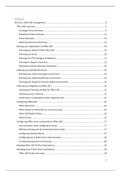Summary
MS-100 Identity & Services Resume Recap Samenvatting MS 100
- Course
- Institution
- Book
Resume MS-100 Identity & Service for the Microsoft 365: MS-100 exam. Al subjects are handled of the microsoft Exam: Design and Implement Microsoft 365 Services (25-30%) Manage domains Add and configure additional domains Configure user identities for new domain name Configure workloads for new dom...
[Show more]




